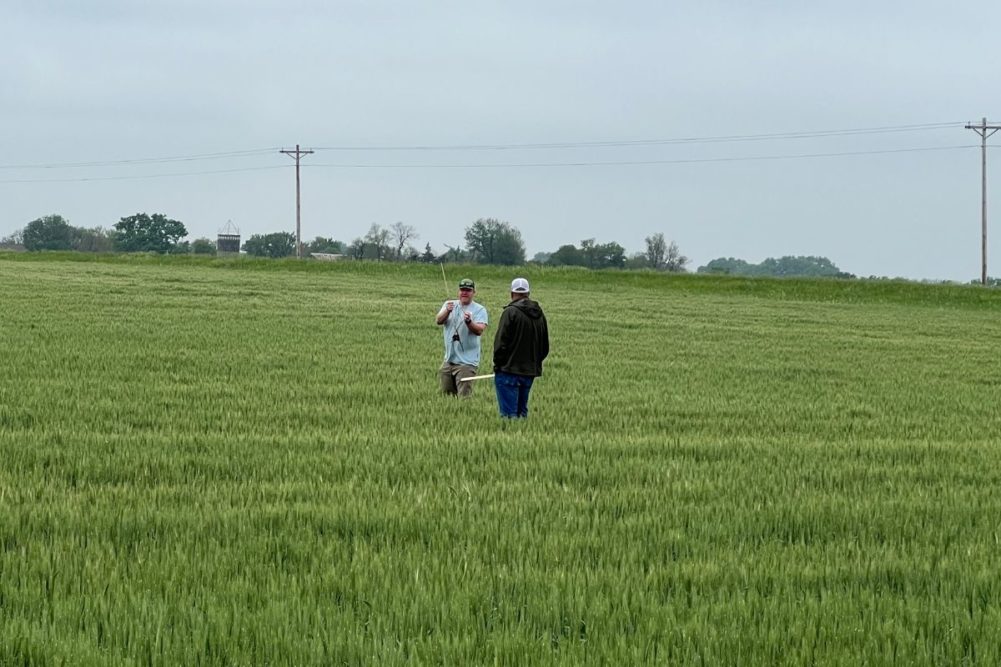MANHATTAN, KANSAS, US — Variability was the key word on Day 1 of the 2023 Hard Winter Wheat tour. Variability in stands, heads, spikelets and height from field to field just a short distance from the other. Variability in evident freeze damage at the top of wheat heads in some areas and no sign of it in others. And variability within a field, ranging from dusty areas devoid of any plants to robust rows sporting 15 to 20 heads per foot.
These diverse conditions and other features were spotted by the record-high 106 scouts taking part in the tour from all along the wheat value chain. Included were farmers, traders, millers, bakers, ingredient suppliers, procurement specialists, agronomists, university researchers and journalists. Scouts divided into foursomes set out from Manhattan, Kansas, US, at dawn in rented SUVs and minivans following one of six assigned color-coded routes all headed west via various state and county roads. With a rough goal of measuring at least two hard winter wheat fields per county, drivers were on the lookout for unfenced fields with safe places to pull in approximately every 25 miles.
Using a formula customized for 2023 by the US Department of Agriculture’s National Agricultural Statistics Service in Manhattan and their trusty Wheat Quality Council yardsticks, scouts measured average plant height, spacing between rows, average spikelets per head, and heads per foot. For some fields well behind the normal development pace for the time of year, NASS offered an early season formula in which tillers per foot were measured rather than heads per foot.
“That’s the lowest Day 1 average in a very long time.” - Aaron Harries, vice president of research and operations for Kansas Wheat
Via a spreadsheet formula loaded on their smartphones or through calculations by hand, scouts determined an estimated bushels-per-acre yield for each visited field, or in some cases determined the field was likely to be terminated. Scouts also appraised each field visually, looking at wheat stands, height variances, and checking for signs of fungal or viral disease, freeze damage or winterkill.
At the end of the day, each foursome submitted its average bus per acre estimate, which in turn were averaged with other vehicles on the same route, which provided an opportunity for comparison with Day 1 in previous tours.
Also, all route color estimates were averaged by Rita Ott of General Mills, Minneapolis, Minnesota, US, for a tour total Day 1 average yield estimate of 29.8 bushels per acre based on 318 total field checks, compared with 39.2 bushels an acre based on 248 field stops in 2022. It was the lowest Day 1 yield estimate of the past 10 tours, and about half of the 59.2 bushels an acre estimated by 2021 tour scouts.
“That’s the lowest Day 1 average in a very long time,” said Aaron Harries, vice president of research and operations for Kansas Wheat and the emcee for the evening meeting. “USDA’s report predicted production in Kansas of 191 million bushels with a yield average of 29 bus an acre, so we’re pretty right on with USDA.”
The end-of-Day 1 meeting was hosted by Frahm Farmland Inc., at the company’s Colby, Kansas, US, event center. As is tradition, a representative from each car offered brief comments on the day’s findings, excursions and estimates. Scouts in some cases told of conversations with farmers who came out to fields to greet scouts and discuss the crop.
One report noted an informative conversation with producer David Evers, who farms numerous fields and several different crops near Great Bend in Barton County, Kansas, US. Evers told a black route foursome he was pleased to have a crop worth harvesting considering he knew of three neighbors who said they weren’t going to bring out their combines this summer, planning to abandon some fields instead. Evers appraised the field in question at 30 bushels per acre at best and was pleased with scouts’ calculated estimates of 39.95 bushels an acre.
Other comments during the car reports echoed the general theme: The crop was shorter than was typical for the date, varied from field to field and within fields, and generally suffered in volume and appearance from the intense drought conditions covering most of Kansas during the entire development period. One route report noted the wide discrepancy between a field estimated at 78 bushels an acre north of Hillsboro in Marion County, Kansas, US, and a dismal 18 bushels an acre in a field west of Bazine in Ness County, Kansas, US. One scout described fields estimated between 20 and 30 bushels an acre that “could have pretty poor test weights without another shot of rain.” Another noted the behind-pace wheat in some areas was just emerging from the boot stage and needed more precipitation to advance properly.
Scouts divided into all-new foursomes were set to depart Colby early Wednesday taking one of six routes straight south, or west and then south, measuring wheat fields along the way before making midday left turns back toward Wichita, Kansas, US, where they were to meet to mull Day 2 findings. Weather forecasts called for partly sunny skies with a high of 80 degrees for Day 2 and rain the following day.
“We expect the wheat you will see tomorrow will not be as good as what you saw today,” Harries said. “We hope we’re wrong about that.”
The hard winter wheat tour is planned and produced by the Wheat Quality Council under the direction of executive vice president Dave Green.






